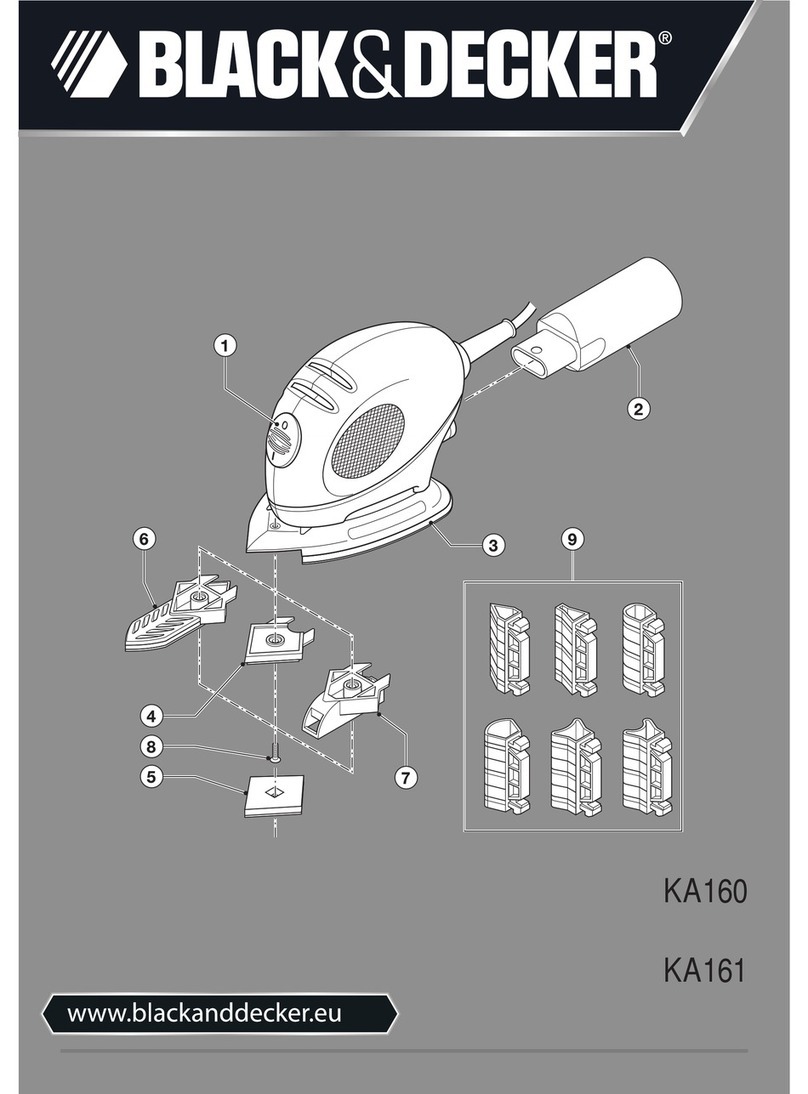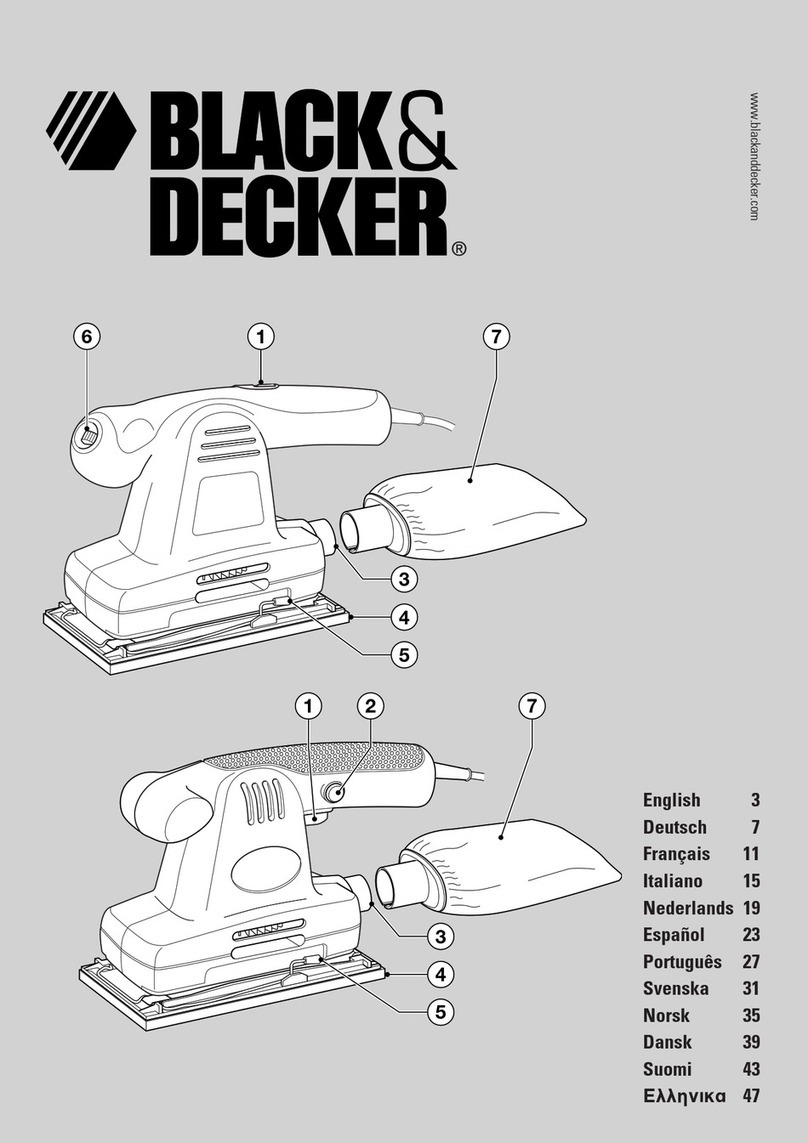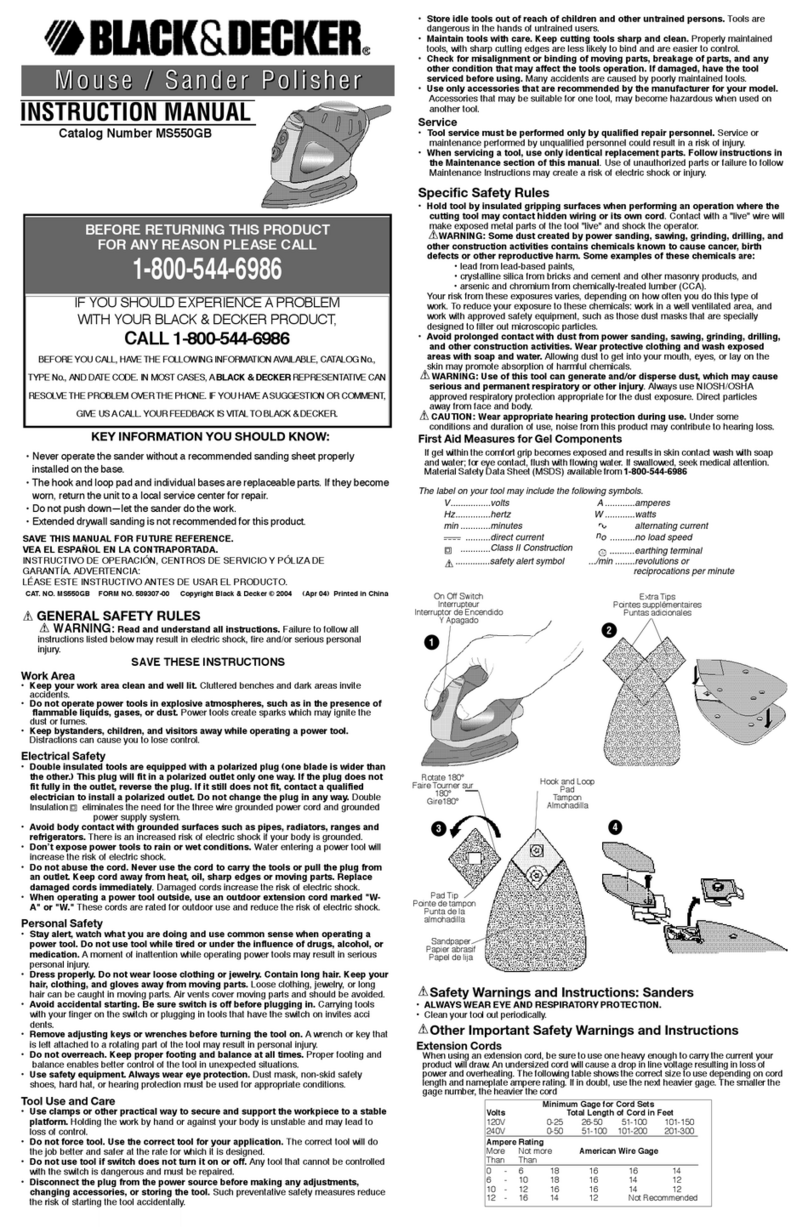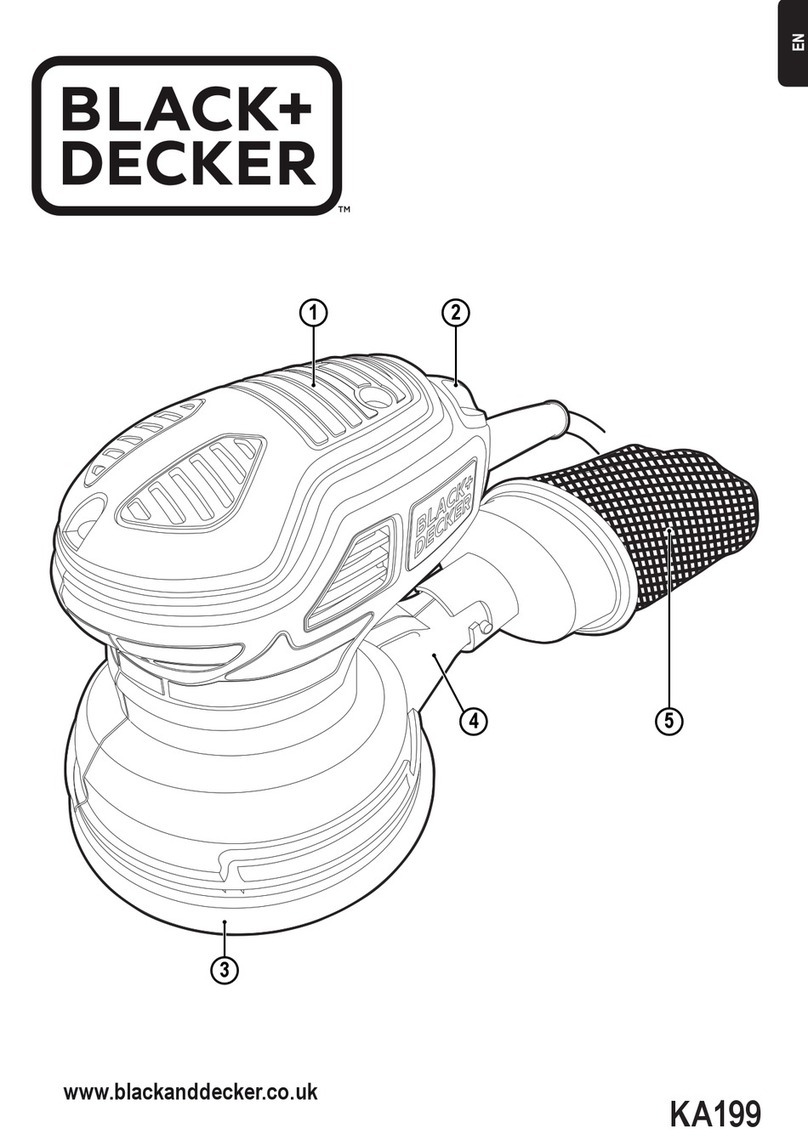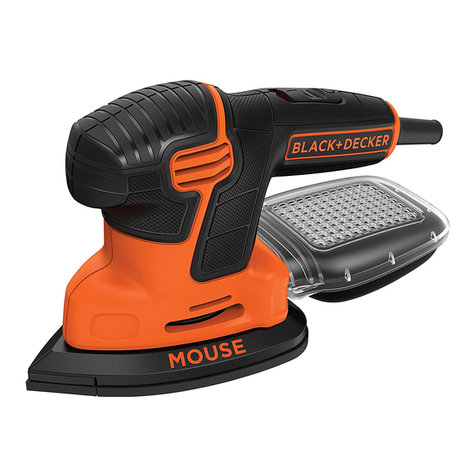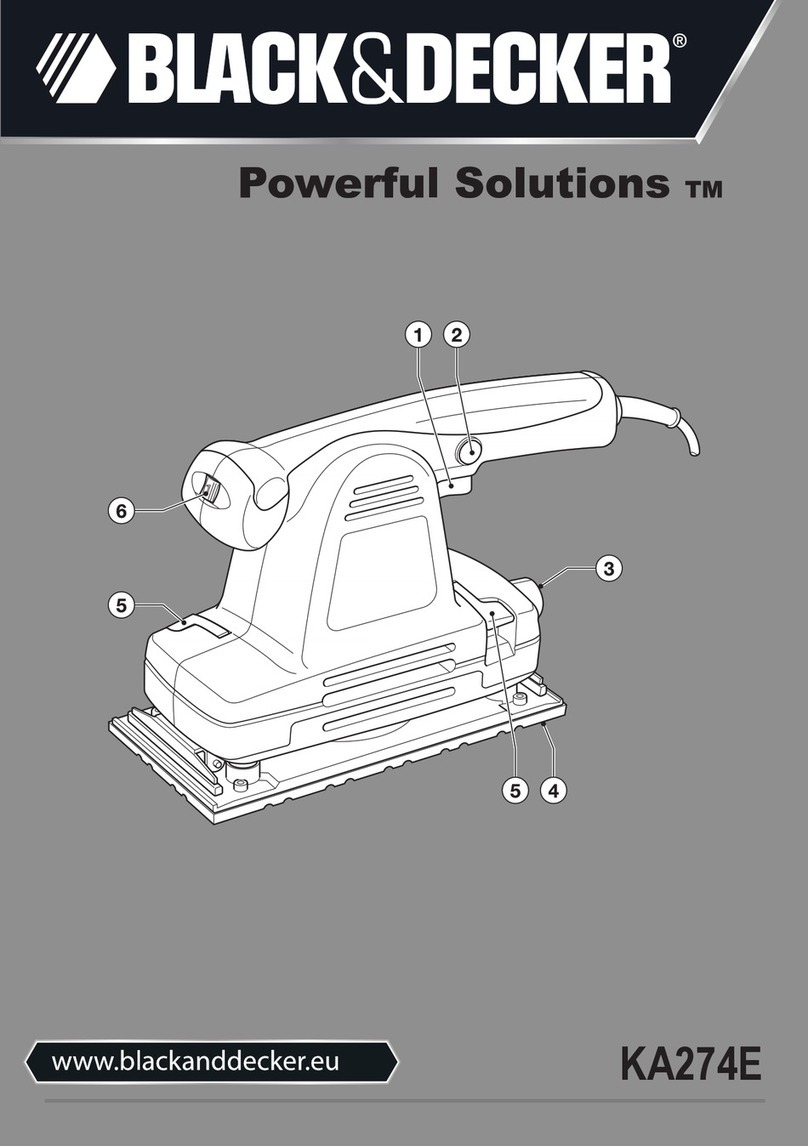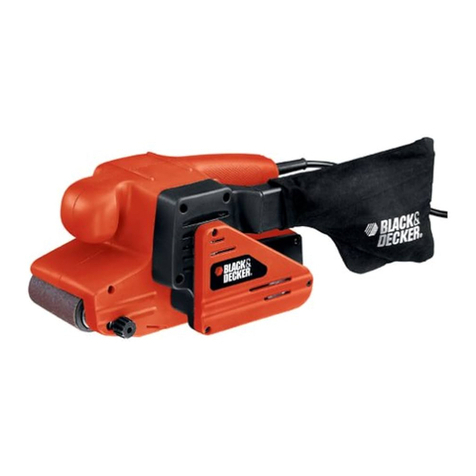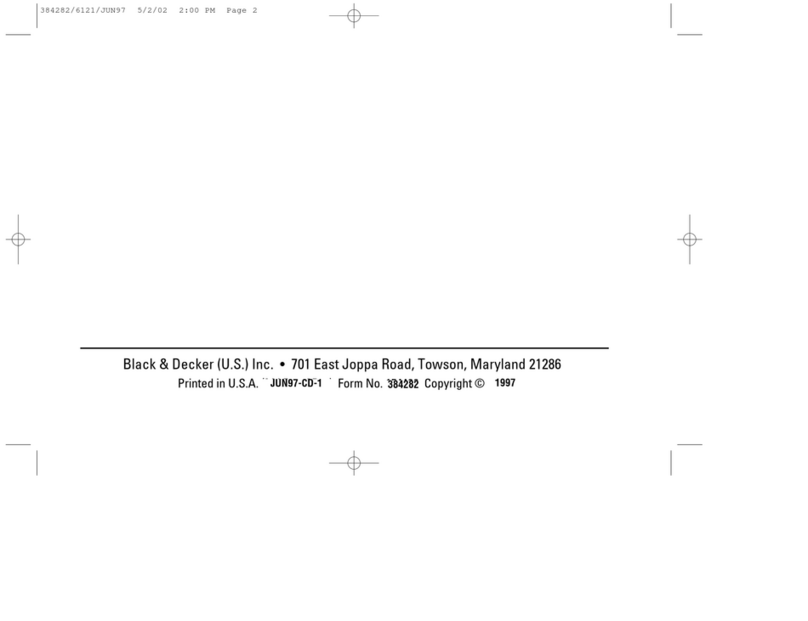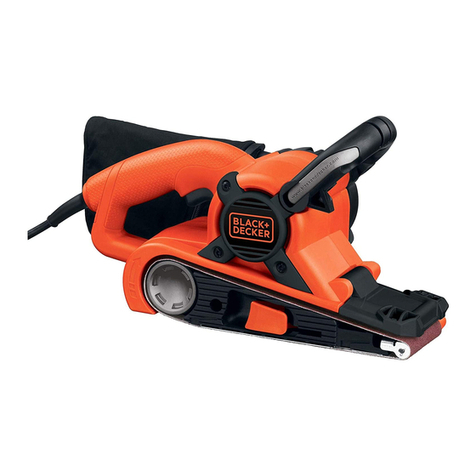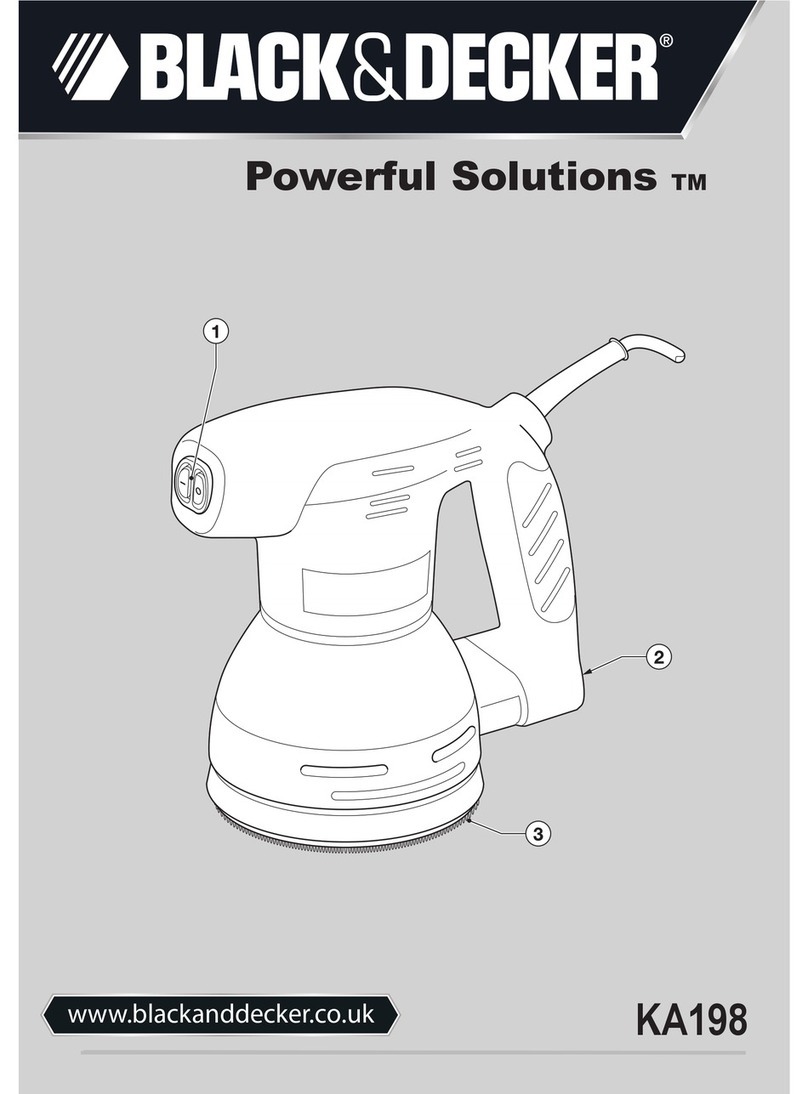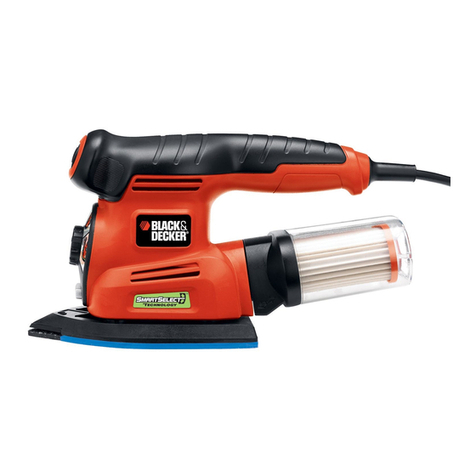Other Important Safety Warnings and Instructions
Sanding
Lead Base Paint
Sanding of lead based paint is NOT RECOMMENDED due to the difficulty of controlling the
contaminated dust. The greatest danger of lead poisoning is to children and pregnant women.
Since it is difficult to identify whether or not a paint contains lead without a chemical analysis,
we recommend the following precautions when sanding any paint:
Personal Safety
• No children or pregnant women should enter the work area where the paint sanding is
being done until all clean up is completed.
• A dust mask or respirator should be worn by all persons entering the work area. The filter
should be replaced daily or whenever the wearer has difficulty breathing.
NOTE: Only those dust masks suitable for working with lead paint dust and fumes should
be used. Ordinary painting masks do not offer this protection. See your local hardware
dealer for the proper (NIOSH approved) mask.
•NO EATING, DRINKING or SMOKING should be done in the work area to prevent
ingesting contaminated paint particles. Workers should wash and clean up BEFORE
eating, drinking or smoking. Articles of food, drink, or smoking should not be left in the work
area where dust would settle on them.
Environmental Safety
• Paint should be removed in such a manner as to minimize the amount of dust generated.
• Areas where paint removal is occurring should be sealed with plastic sheeting of 4 mils
thickness.
• Sanding should be done in a manner to reduce tracking of paint dust outside the work area.
Cleaning And Disposal
• All surfaces in the work area should be vacuumed and thoroughly cleaned daily for the
duration of the sanding project. Vacuum filter bags should be changed frequently.
• Plastic drop cloths should be gathered up and disposed of along with any dust chips or
other removal debris. They should be placed in sealed refuse receptacles and disposed of
through regular trash pick-up procedures. During clean up, children and pregnant women
should be kept away from the immediate work area.
• All toys, washable furniture and utensils used by children should be washed thoroughly
before being used again.
otor
Be sure your power supply agrees with nameplate marking. 120 or 220 Volts AC only means
your tool will operate on standard 50 or 60 Hz household power. Do not operate AC tools on
DC. A rating of 120 or 220 Volts AC/DC means that your tool will operate on standard 50 or
60 Hz AC or DC power. This information is printed on the nameplate. Lower voltage will
cause loss of power and can result in over-heating. All Black & Decker tools are factory-
tested; if this tool does not operate, check the power supply.
SAVE THESE INSTRUCTIONS
Adjustments
WARNING: To prevent accidental operation, turn off and unplug sander before per-
forming the following operations. Failure to do this could result in serious
personal injury.
Adjusting The Sanding Belt Tracking
Your belt sander has an automatic sanding belt tracking device. No adjustment is required.
Changing The Sanding Belt - Figure 1 & 2
WARNING: To prevent accidental operation, turn off and unplug sander before
changing the sanding belt.
Pull the lever shown in Figure 1 to release the tension on the sanding belt. Pull the sanding
belt from the two rollers. Put the new 3"x18" (75 x 457mm) sanding belt in position on the
front and rear rollers (Figure 2). Ensure that the arrows on the sanding belt and on your belt
sander are pointing in the same direction. Push the lever to the rear to tension the sanding
belt. Warning: To reduce the risk of injury, make sure belt is installed with arrows in proper
direction of rotation. WARNING: To reduce the risk of injury, make sure belt is installed
with arrows in proper direction of rotation. Failure to do this could result in the belt unraveling
creating a hazardous condition.
Dust Collection - Figure 3
WARNING: To prevent accidental operation, turn off and unplug sander before
installing the dust bag.
When using your belt sander, dust and grit are produced. It is important to use a dust bag.
Connect the dust bag by sliding the plastic opening of the bag down over the dust exhaust
port of the sander as shown in Figure 3. To empty the dust bag, remove it from the sander
and unzip the bag over a trash container.
Note: A vacuum cleaner attachment is available as a service part at extra cost. To find your
nearest Black & Decker Service Center location, refer to the yellow pages directory under
"Tools—Electric" or call the neaest Authorized Service Center.
WARNING: Fire hazard. Collected sanding dust from sanding surface coatings
(polyurethane, linseed oil, etc.) can self-ignite in sander dust bag or elsewhere and
cause fire. To reduce risk, empty bag frequently and strictly follow sander manual and
coating manufacturer's instructions.
WARNING: Fire hazard. When sanding wood that could contain nails or when
sanding metal surfaces, do not use the dust bag or a vacuum cleaner because sparks
are generated. Wear safety glasses and a dust mask. Due to the danger of fire, do not
use your belt sander to sand magnesium surfaces. Do not use for wet sanding.
OPERATION
Using Your Belt Sander - Figure 4
Always hold belt sander firmly with both hands while sanding as shown in Figure 4.
WARNING: Severe abrasion hazard. Always hold the belt sander with one hand on
the switch handle and the other hand on the front handle. Never operate the belt
sander in an inverted stationary position as shown in figure 4a.
Switch - Figure 5 & 6
To start your belt sander, depress the on/off switch as shown in Figure 5. To stop your belt
sander release the on/off switch. For continuous operation, depress the on/off switch then
depress the lock-on button (Figure 6) and release the on/off switch. To stop your belt sander,
depress the on/off switch to release the lock-on button. Release the on/off switch.
Handy Hints
• Always start your belt sander before it is in contact with the workpiece and do not switch it
off until after it has been lifted from the workpiece.
• Always hold your belt sander with two hands.
• Where possible, clamp the workpiece to a work bench or similar sturdy surface.
• Use the correct grit sanding belt for your application. The following is a suggested list of belt
grits to use with different materials.
ATERIAL BELT GRIT
Solid Wood 80
Veneer 150
Chipboard 60/80
Plastics 100
Steel 80 (remove dust bag)
Paint Removal 40/60
Balsa Wood 100
Acrylic 100
Tool Care And aintenance
Never apply excessive force when you use your belt sander. Too much force can result in an
overload and cause damage to the motor or the workpiece. If your belt sander becomes too
hot, operate it without load for 2 minutes. Always keep the air cooling vents clear. To clean
your belt sander, proceed as follows:
WARNING: To prevent accidental operation, turn off and unplug sander before per-
forming the following operations. Failure to do this could result in serious
personal injury.
• Use a clean dry paint brush to clear vents and ducts.
• Clean the housings using a clean damp cloth (do not use solvents, gas or turpentine.)
I PORTANT: To assure product SAFETY and RELIABILITY, repairs, maintenance and
adjustment should be performed by authorized service centers or other qualified service
personnel, always using identical replacement parts.
dust mask, non-skid safety s oes, ard at, or earing protection used for appropriate
conditions will reduce personal injuries.
c) Avoid accidental starting. Ensure the switch is in the off-position before plugging
in. Carrying power tools wit your finger on t e switc or plugging in power tools t at
ave t e switc on invites accidents.
d) Remove any adjusting key or wrench before turning the power tool on. A wrenc
or a key left attac ed to a rotating part of t e power tool may result in personal injury.
e) Do not overreach. Keep proper footing and balance at all times. T is enables bet-
ter control of t e power tool in unexpected situations.
f) Dress properly. Do not wear loose clothing or jewelry. Keep your hair, clothing
and gloves away from moving parts. Loose clot es, jewelry or long air can be
caug t in moving parts. Air vents often cover moving parts and s ould also be avoided.
g) If devices are provided for the connection of dust extraction and collection
facilities, ensure these are connected and properly used. Use of t ese devices can
reduce dust-related azards.
4) Power tool use and care
a) Do not force the power tool. Use the correct power tool for your application. T e
correct power tool will do t e job better and safer at t e rate for w ic it was designed.
b) Do not use the power tool if the switch does not turn it on and off. Any power tool
t at cannot be controlled wit t e switc is dangerous and must be repaired.
c) Disconnect the plug from the power source and/or the battery pack from the
power tool before making any adjustments, changing accessories, or storing
power tools. Suc preventive safety measures reduce t e risk of starting t e power
tool accidentally.
d) Store idle power tools out of the reach of children and do not allow persons
unfamiliar with the power tool or these instructions to operate the power tool.
Power tools are dangerous in t e ands of untrained users.
e) aintain power tools. Check for misalignment or binding of moving parts,
breakage of parts and any other condition that may affect the power tools
operation. If damaged, have the power tool repaired before use. Many accidents
are caused by poorly maintained power tools.
f) Keep cutting tools sharp and clean. Properly maintained cutting tools wit s arp
cutting edges are less likely to bind and are easier to control.
g) Use the power tool, accessories and tool bits etc., in accordance with these
instructions and in the manner intended for the particular type of power tool,
taking into account the working conditions and the work to be performed. Use of
te power tool for operations different from t ose intended could result in a azardous
situation.
5) Service
a) Have your power tool serviced by a qualified repair person using only identical
replacement parts. T is will ensure t at t e safety of t e power tool is maintained.
SPECIFIC SAFETY RULES
•Hold tool by insulated gripping surfaces when performing an operation where the
cutting tool may contact hidden wiring or its own cord. Contact with a "live" wire will
make exposed metal parts of the tool "live" and shock the operator.
•Use clamps or another practical way to secure and support the work piece to a
stable platform. Holding the work by hand or against your body leaves it unstable and
may lead to loss of control.
WARNING: Some dust created by power sanding, sawing, grinding, drilling, and
other construction activities contains chemicals known to cause cancer, birth defects
or other reproductive harm. Some examples of these chemicals are:
• lead from lead-based paints,
• crystalline silica from bricks and cement and other masonry products and
• arsenic and chromium from chemically-treated lumber. (CCA)
Your risk from these exposures varies, depending on how often you do this type of work. To
reduce your exposure to these chemicals: work in a well ventilated area, and work with
approved safety equipment, such as those dust masks that are specially designed to filter
out microscopic particles.
•Avoid prolonged contact with dust from power sanding, sawing, grinding, drilling,
and other construction activities. Wear protective clothing and wash exposed areas
with soap and water. Allowing dust to get into your mouth, eyes, or lay on the skin may
promote absorption of harmful chemicals.
WARNING: Use of this tool can generate and/or disburse dust, which may cause
serious and permanent respiratory or other injury. Always use NIOSH/OSHA approved
respiratory protection appropriate for the dust exposure. Direct particles away from face and
body.
CAUTION: Wear appropriate hearing protection during use. Under some conditions
and duration of use, noise from this product may contribute to hearing loss.
SAFETY GUIDELINES - DEFINITIONS
It is important for you to read and understand this manual.
The information it contains relates to protecting YOUR
SAFETY and PREVENTING PROBLEMS. The symbols below are used to help you
recognize this information.
DANGER: Indicates an imminently hazardous situation which, if not avoided, will result
in death or serious injury.
WARNING: Indicates a potentially hazardous situation which, if not avoided, could
result in death or serious injury.
CAUTION: Indicates a potentially haz ard ous situation which, if not avoided, may result
in minor or mod er ate injury.
CAUTION: Used without the safety alert symbol indicates potentially hazardous situation
which, if not avoided, may result in property damage.
Extension Cords
When using an extension cord, be sure to use one heavy enough to carry the current your
product will draw. An undersized cord will cause a drop in line voltage resulting in loss of
power and overheating. The following table shows the correct size to use depending on cord
length and nameplate ampere rating. If in doubt, use the next heavier gage. The smaller the
gage number, the heavier the cord.
T e label on your tool may include t e following symbols.
V ..................volts A ......................amperes
Hz ................ ertz W......................watts
min ..............minutes ..................alternating current
............direct current no....................no load speed
................Class II Construction ..................eart ing terminal
................safety alert symbol .../min ..............revolutions or reciprocations
per minute
Safety Warnings and Instructions: Sanders
•ALWAYS WEAR EYE AND RESPIRATORY PROTECTION.
• Clean your tool out periodically.
inimum Gage for Cord Sets
Volts Total Length of Cord in Feet
120V 0-25 26-50 51-100 101-150
(0-7,6m) (7,6-15,2m) (15,2-30,4m) (30,4-45,7m)
220V 0-50 51-100 101-200 201-300
(0-15,2m) (15,2-30,4m) (30,4-60,9m) (60,9-91,4m)
Ampere Rating
More Not more American Wire Gage
Than Than
0-6 18 16 16 14
6-10 18 16 14 12
10 - 12 16 16 14 12
12 - 16 14 12 Not Recommended

